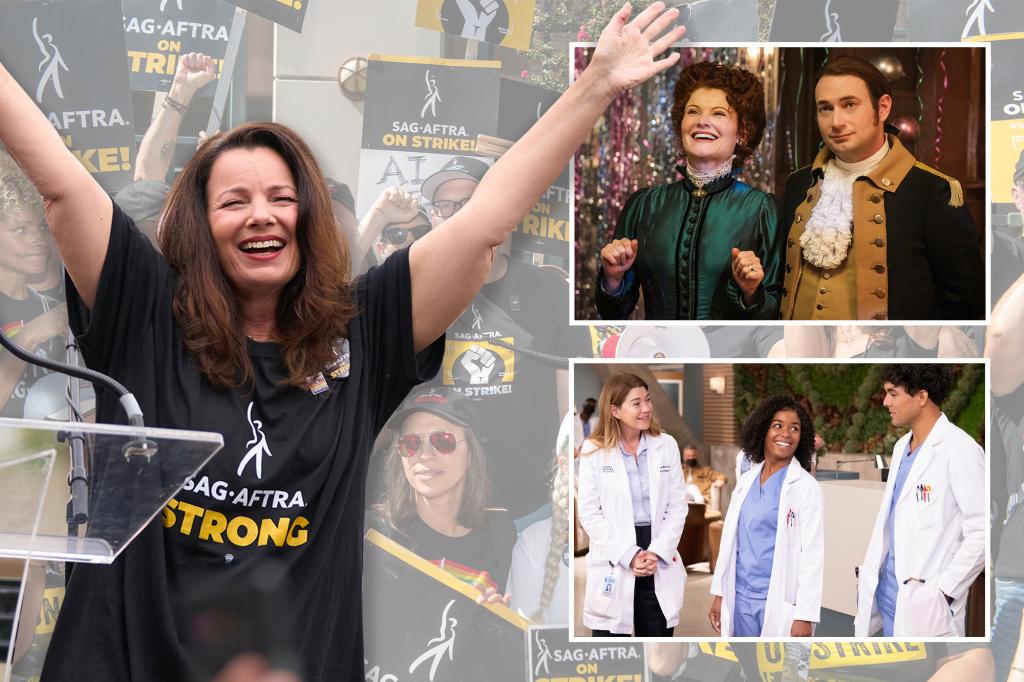The end of the SAG-AFTRA strike hinges on final approval from guild members — but it is, without a doubt, good news for those who earn their living in the entertainment industry (and for those, like me, who write about it).
After 118 days on the picket lines, it’s back to work for actors, directors, crew members, etc., and a return to some level of normalcy (we hope) after nearly four months of off-air turbulence — and oft-rancorous talk between SAG-AFTRA (in the person of its president, Fran Drescher) and the major Hollywood studios (AMPTP).
It’s a rinse-and-repeat following on the heels of the writers’ guild (WGA), which ended its strike in early October after five months as TV scribes headed back to their writers rooms to crank out late-night monologues or plan for new episodes of their series.
“I’m thrilled it’s over,” former “Parks and Recreation” co-star Jim O’Heir told me from Kansas City, where he’s starring in a play (“Catch Me If You Can”) during his strike-enforced downtime from television. “My heart goes out to the local line workers who were affected by this nightmare,” he said. “They haven’t been working and some of them don’t have people protecting them. So I’m happy for them we’re all going back.
“That’s all we wanted to do,” he added. “I was on the picket line a lot and nobody out there was like, ‘This is so much fun!’ It sucked; I’m a big guy and having to walk around Disney … it was like a mile around the place.”
“There is absolutely a lot of enthusiasm right now to go back to what we know and what we do. Everyone is elated,” Hollywood talent manager Lynda Bensky told me. “There will be a break of a few weeks, at least for the actors, because they’re the last [people] on the set and the productions have to get all their crews, locations and sets in place.”
Specific details of the three-year SAG-AFTRA/AMPTP agreement, valued at over $1 billion, will be revealed in the coming weeks, including news on pay raises, bigger cuts of streaming revenue and scaling back AI’s impact on actors/background extras.
“AI and streaming had to be addressed,” O’Heir said. “I couldn’t be happier and I’m anxious to see what’s in the deal, but what I’m being told is that we made huge gains. It was time. It had to happen.”
If we could paraphrase the verbiage on a car’s side mirror: the return of shows might not be as close as it appears.
The strike wreaked havoc on the networks’ fall schedules, so viewers thirsting for fresh programming will, in the best-case scenario, have to wait, perhaps until March, for their favorite shows including “Grey’s Anatomy” and “Ghosts,” to return with new episodes in abbreviated seasons.
Many shows will go back into production in the days/weeks following Thanksgiving, but it takes time to get a series running and filming episodes after such a long hiatus. Raring to go is one thing; being realistic is another.
“I think the enthusiasm that comes with the strike ending after all this time will push people to move faster,” Bensky said. “We’ve got the holidays coming up — this town usually takes off from Thanksgiving on [through the end of the year] but I wonder if people are going to hunker down and work through it. I think [the end of the strike] will accelerate everything we have to do.”
With a few exceptions, though, it’s expected that most of the new and returning network shows will be back next fall.
“I don’t think production will come back until early next year,” O’Heir said. “I think some shows that shut down in the middle [of production] might be able to come back quicker, but now they’ve got to build sets, rent out soundstages, etc.”
The strike and the four-month shutdown impacted the networks’ nightly schedules in other ways, forcing CBS, for instance, to move two of its fall series to next fall: “Poppa’s House,” starring Damon Wayans and Damon Wayans Jr., and a reboot of “Matlock” (starring Kathy Bates).
But it also pivoted in adjusting to the dearth of new programming by rerunning corporate sister Paramount Network’s “Yellowstone” on Sunday nights to solid viewership — and will now follow suit by airing the first two episodes of the Paramount+ series “Lawmen: Bass Reeves” following “Yellowstone” (‘natch) starting Nov. 12.
Streaming series are at less of a disadvantage, since the bulk of shows that premiered since the strike began were filmed before the work stoppage, though actors were not permitted to publicize their projects, including Kelsey Grammer, who launched his Paramount+ reboot of “Frasier” Oct. 12.
Some cable shows remained unaffected, particularly those with long lead times: “House of the Dragon,” HBO’s “Game of Thrones” spinoff, is expected to return this summer for its second season. But the second half of Season 5 of “Yellowstone” won’t be back until next November (with or without star Kevin Costner).
Unscripted shows (“The Golden Bachelor,” “Survivor,” “Dancing With the Stars” and “The Voice,” et al.) were unaffected by either the WGA or SAG-AFTRA strikes — but the cold reality (pun intended) is that the work stoppage (necessarily) spawned a creative vacuum for the broadcast networks vis-a-vis comedies and dramas, with only a few new shows (such as NBC’s “The Irrational” and “Found“) filling the void among a sea of repeats.
This is what we’ll call delayed viewing for now … and viewers’ patience is about to be put to the test.
“Last night I got a call from a friend who works on [ABC’s] ‘The Rookie’ and they’re already talking about scheduling,” O’Heir said.
“These shows want to get back to work.”
Source link









